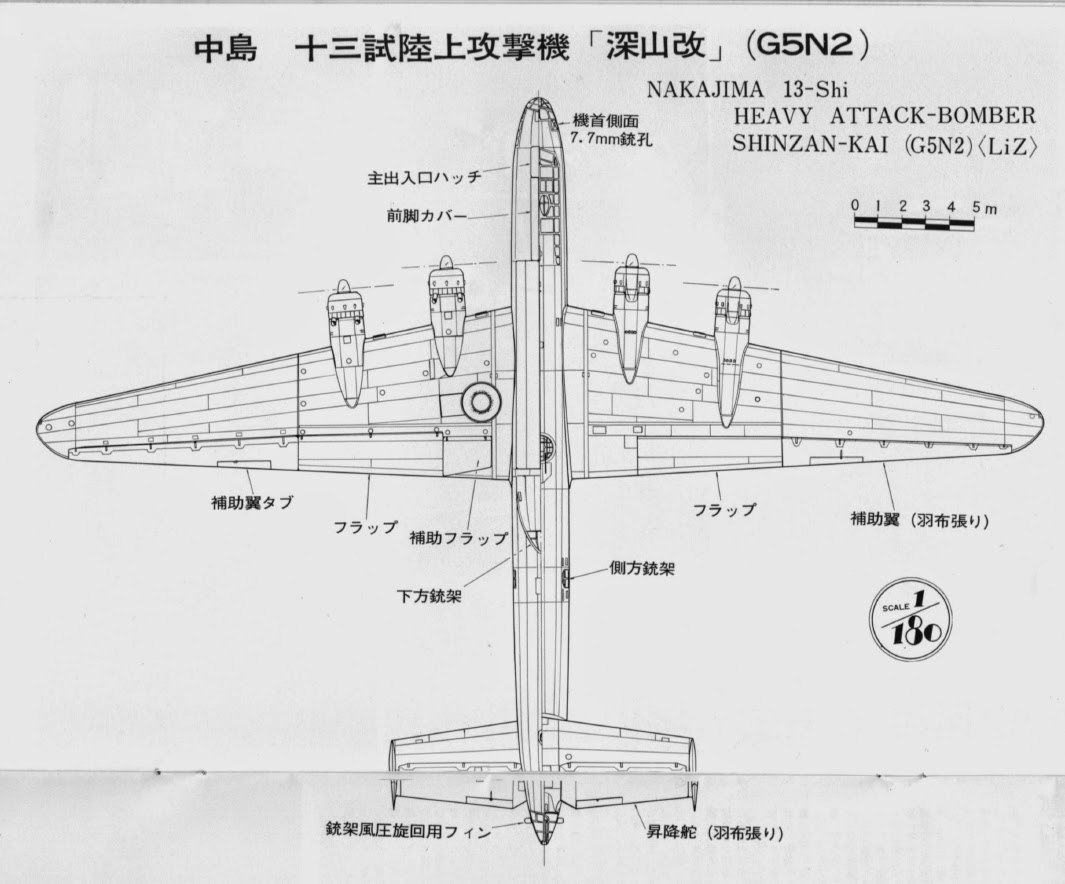The Nakajima G5N Shinzan ("Mountain Recess") was a four-engined
long-range heavy bomber designed and built for the Imperial
Japanese Navy prior to World War II. The Navy designation was
"Experimental 13-Shi Attack Bomber"; the Allied code name was
"Liz".
The Nakajima G5N Shinzan originated due to the Imperial Japanese
Navy's interest in developing a long-range attack bomber capable of
carrying heavy loads of bombs or torpedoes a minimum distance of
3,000 nmi (5,600 km; 3,500 mi). To meet this requirement, it became
apparent a four-engine lay-out would be necessary. As Japanese
aircraft manufacturers lacked experience in building such large
complex aircraft, the Navy was forced to search for a suitable
existing foreign-made model upon which to base the new design. It
settled on the American Douglas DC-4E airliner. In 1939 the sole
prototype of this airliner (previously rejected by American airline
companies) was purchased by Nippon Koku K.K. (Japan Airlines Co)
and clandestinely handed over to the Nakajima Aircraft Company for
dismantling and inspection.
The design that emerged from this study was for an all-metal
mid-wing monoplane with fabric-covered control surfaces and powered
by four 1,870hp Nakajima NK7A Mamoru 11 air-cooled radial engines
driving four-bladed propellers. Notable features included a long
ventral bomb-bay, glazed nose and twin tailfins replacing the
DC-4E's distinctive triple rudder. The DC-4E's retractable tricycle
undercarriage was retained, as well as the original wing form and
powerplant arrangement. Defensive armament comprised one 20mm Type
99 Model 1 cannon each in a power-operated dorsal and tail turret
plus single-mount hand-operated 7.7mm Type 97 machine guns in the
nose, ventral and beam positions.
The first prototype G5N1 made its maiden flight on 10 April
1941. Overall performance proved disappointingly poor however, due
to a combination of excessive weight, the unreliablity of the
Mamoru engines and the complexity of the design. Only three more
prototypes were completed. In an attempt to salvage the project,
two additional airframes were fitted with 1,530hp Mitsubishi MK4B
12 "Kasei" engines and redesignated G5N2s. Although the Mitsubishi
engines were more reliable than the original Mamoru 11s, the
aircraft was now even more hopelessly underpowered and further
development of the type was halted.
Of the six completed Shinzans, four of them (two G5N2s and two
G5N1s re-engined with the Kasei 12) were relegated for use as
long-range Navy transports under the designation Shinzan-Kai Model
12 Transport G5N2-L. The Allies allocated the code-name "Liz" to
the aircraft, in the expectation it would be used as a bomber.
Variants
* G5N1: Four-engined heavy bomber. Production
version, four built.
* G5N2: Four Mitsubishi MK4B 12 "Kasei"
radial engines in place of Nakajima Mamoru 11 engines. Two
built.
* G5N2-L: Long-range Navy transport
conversion.
Proposed Variants
* Nakajima Ki-68: Japanese Army heavy bomber.
Four Mitsubishi Ha-101 or Nakajima Ha-103 engines.
* Kawanishi Ki-85: Japanese Army heavy
bomber. Four Mitsubishi Ha-111M engines.
Specifications (G5N1)
General characteristics
* Crew: 7-10
* Length: 31.02 m (101 ft 9 in)
* Wingspan: 42.12 m (138 ft 2 in)
* Height: 8.4 m (27 ft 6 in)
* Wing area: 201.8 m² (2,171.37 ft²)
* Empty weight: 20,100 kg (44,300 lb)
* Loaded weight: 28,150 kg (62,060 lb)
* Max takeoff weight: 32,000 kg (70,528
lb)
* Powerplant: 4× Nakajima NK7A "Mamoru-11"
14-cylinder air-cooled radial four-blade constant-speed, 1395 kW
(1870 hp) each
Performance
* Maximum speed: 420 km/h (227 kn, 261
mph)
* Cruise speed: 370 km/h (200 kn, 230
mph)
* Range: 4,260 km (2,302 nmi, 2,648 mi)
* Service ceiling: 7,450 m (24,442 ft)
Armament
* Guns
* 2× 20 mm Type 99 cannons
* 4× 7.7 mm (0.303 in) Type 97 machine
guns
* Ordinance
* 2,000-4,000 kg (4,408-8,816 lb) bombs



No comments:
Post a Comment